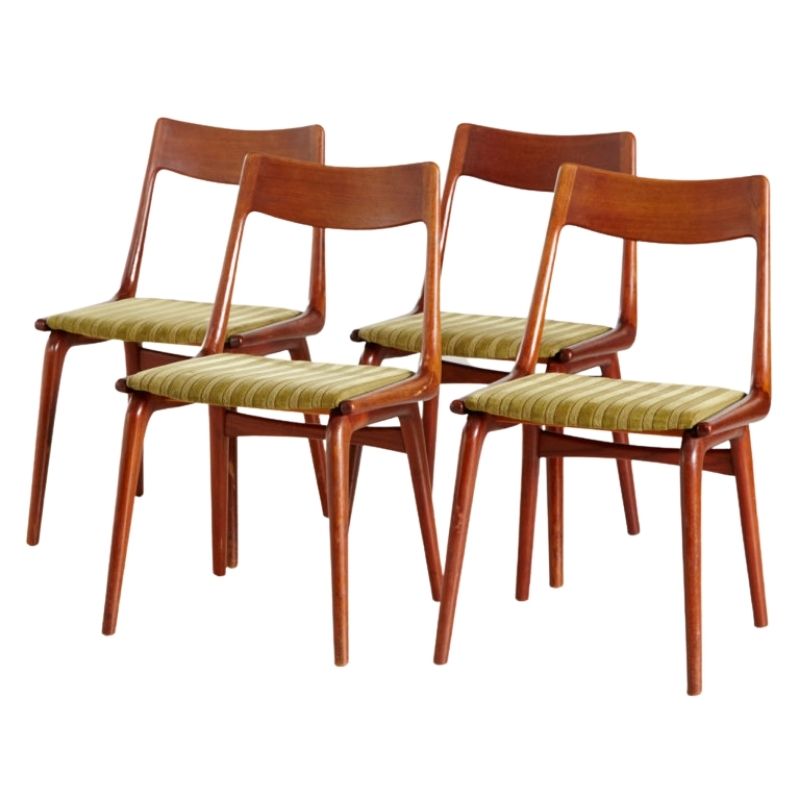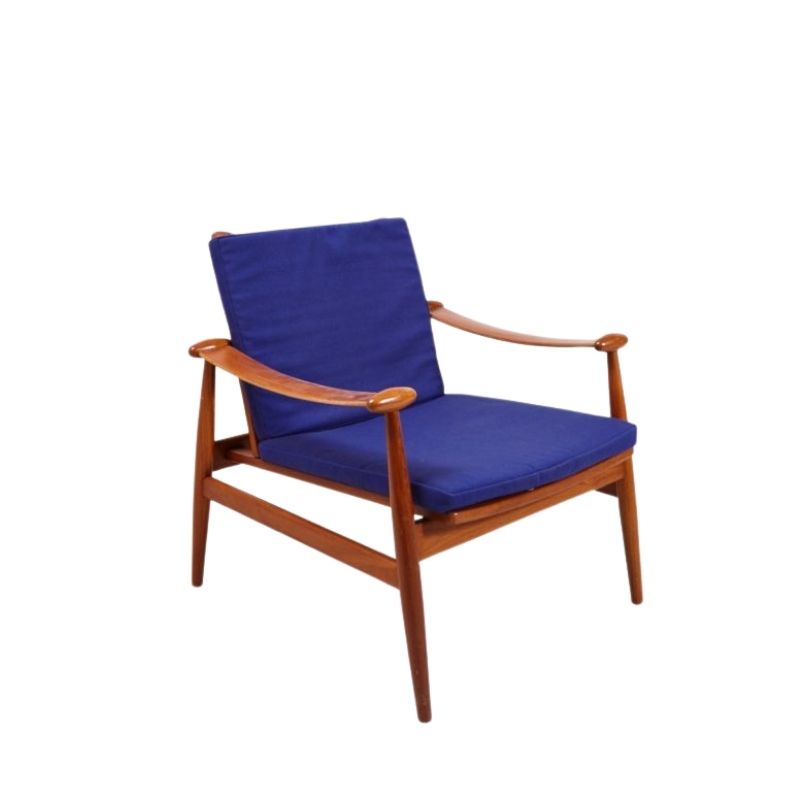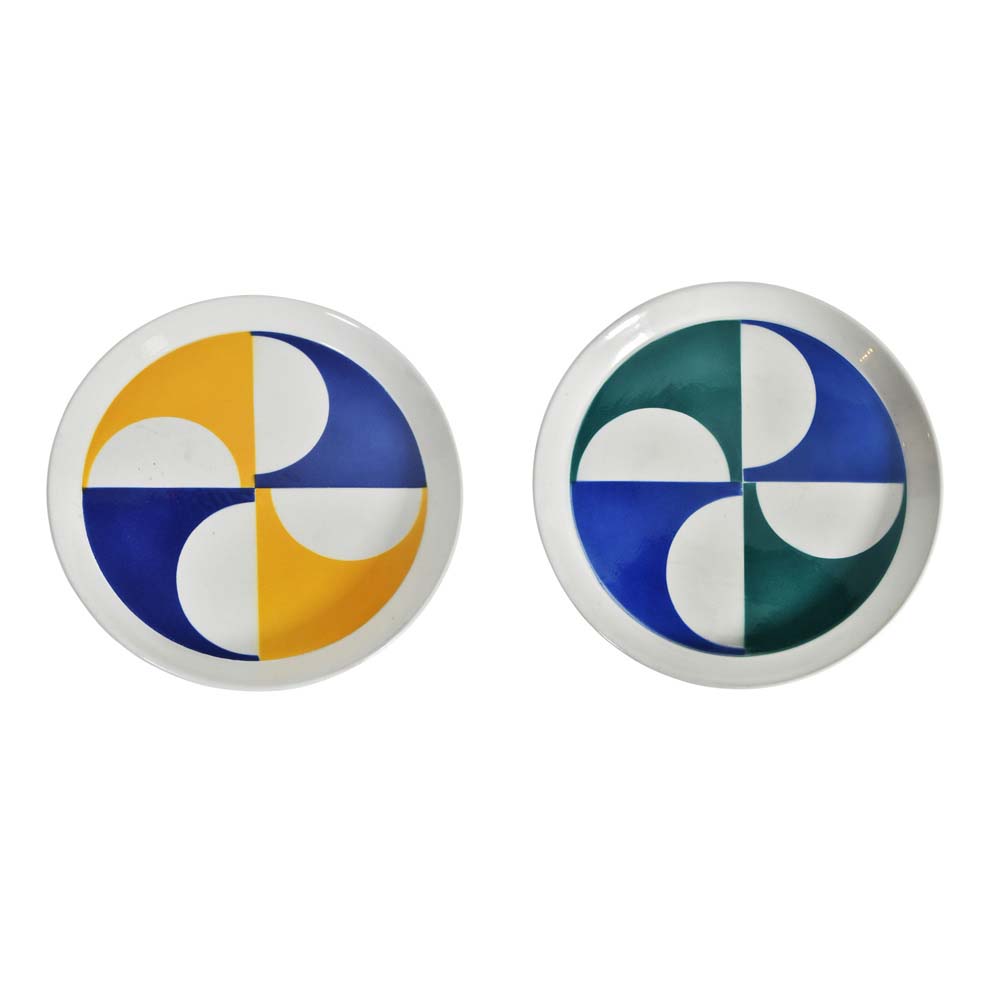Definitely stained beech.
When beech is stained, as Cd was talking about, the grain takes the stain differently. Some areas will soak the stain into the grain pretty deeply (especially the end-grain). To remove this stain, one must sand quite deep. I think it is this heavy sanding that worries most refinishers, as you need to be very conscious of what you are doing to maintain the original sculpting of the piece, and not compromise the design or structural integrity.
In my first stained beech refinishing attempts (a pair of Wegner-esque Yugo folding rope chairs), I was amazed at how deep I needed to sand, and I still did not get all of the pigment out. If you dont get all the pigment out, the grain ends-up looking 'dirty'. The results are uneven and mottled (as you are seeing on the arms of your chair), much worse usually than what was started with. These issues seem to be made worse with increased weathering of the original finish.
I have found that there is really only 2 good options for DIY refinishing of deeply stained or weathered beech:
1. Try to repair the original finish
2. stain black with india ink or lacquer
There are certainly more 'professional' options, but without the ability to spray toners and a very strong understanding of applying finishes, there just are not many good options to get back to the original faux walnut finish.
I have a Folke Ohlsson lounge chair for Dux, that is walnut-stained beech. I am facing the same decision on how to improve it. Fortunately, the finish is in far better shape than the Selig chair that you have, so I hope to get favorable results with #1 above.
The person refinishing your chairs is either going to need to sand much more deeply, or figure out how to apply stain/toner combinations to even out the mottling.
Beech, Birch and Maple are very difficult to refinish once darkly stained, and I would strongly urge any DIY refinshers out there to learn how to identify it, and steer clear until after they have lots of practice on inconsequential items.
These short little rays are the most easily identified characteristics of beech. It's not hard to ID this wood once you know what to look for. You won't see the rays on every piece of beech but that's because they are only visible on boards cut at a certain angle from the log.
http://www.core77.com/posts/24890/how-logs-are-turned-into-boards-part-1...
I've run into this issue with beech myself and even after lots and lots of sanding, some stain remained. I ended up ebonizing with permanent India ink, a very easy process, and loved the results. (But I'm also not a fan of trying to make a species of wood look like something it's not. It rarely works, at least not when the fake color gets scratched through here and there, or it fades to a third color altogether from sun exposure over the years. And yeah, ebonizing is supposed to make it look like ebony---but scratches in India ink are also super easy to touch up, and the issue of mismatched grain is minimized, so...)
If you're not familiar with ebonizing, here's a Kofod-Larsen chair that I ebonized awhile back. It's beech. The original finish was a walnut-tinted varnish and stain that had turned an ugly green on the entire right side of the chair which I'm guessing was exposed to a sunny window for many years. Short of sanding it to death (and maybe not even then), this was the best option. (I'm sure there are some who will argue with me on this point, but oh well.)
The before photos don't show the green color very well, but trust me--it was a deep greenish brown. Very unfortunate.
Every manufacturer of wood products has a disclaimer something like this randomly stolen one--
'Wood grain is a product of nature, and much like a fingerprint, no two grain patterns are ever exactly alike. This individualism is one of the most appealing factors of wood products. Soil and climate affect the growth characteristics of wood. The finest hardwoods have certain natural characteristics that cannot be hidden with a finishing process. These characteristics occur due to the fact that wood is a natural product and is affected by weather, climate, insects, birds, soil makeup, and natural growth patterns. These characteristics are apparent and are not to be misinterpreted as defects. Wood is a product of nature- and as such will display natural characteristics and variances that are unique to each and every cut. These characteristics are an integral part of the charm and beauty of real
wood - no two pieces are alike.'
Well.
Politely ask the professional refinisher if there will be a charge for the re-do. And then stare him in the eyeballs...and absolutely say nothing until he/she responds. Certainly the answer should be "no-charge". Professionals build strong reputations by standing behind their workmanship. I am more concerned that the refinisher sent the pieces back with such a result...be it on beech, or any other wood.
Do consider slipping him $50. and a bottle of scotch. Don't pay for a re-do.
Don't,
Aunt Mark
Mark, I disagree. The OP told the refinisher what to do and he did it. When you tell someone you want a whisky and they pour you Jack Daniels, and you complain that this whiskey taste bad, well who is at fault? The guy who said I want a whiskey, or the guy who poured the whiskey?
Of course a nice bartender may take back the Jack Daniels and pour you something else, but any self-respecting bartender will also brand you an unpleasant unreliable customer. This is not good for a long term bar patron - bar tender relationship. He responsible thing to do is to order another whisky, pay for both, and leave a good tip because you spurned the first pour.
Zephyr and cdsilva's posts are most interesting and insightful to me and I think it's a real possibility that both of the OP's chairs are beech and that they've both been refinished.
I don't have a lot of experience refinishing beech, but enough to know that it behaves much like many other close-grain, furniture-grade hardwoods that accept pigment stains unevenly (i.e. birch, maple, cherry). The provided photos illustrate a rookie attempt, IMO, and the responsible individual should be grateful for the opportunity to correct the mistake and keep the original fee.
If you need any help, please contact us at – info@designaddict.com









